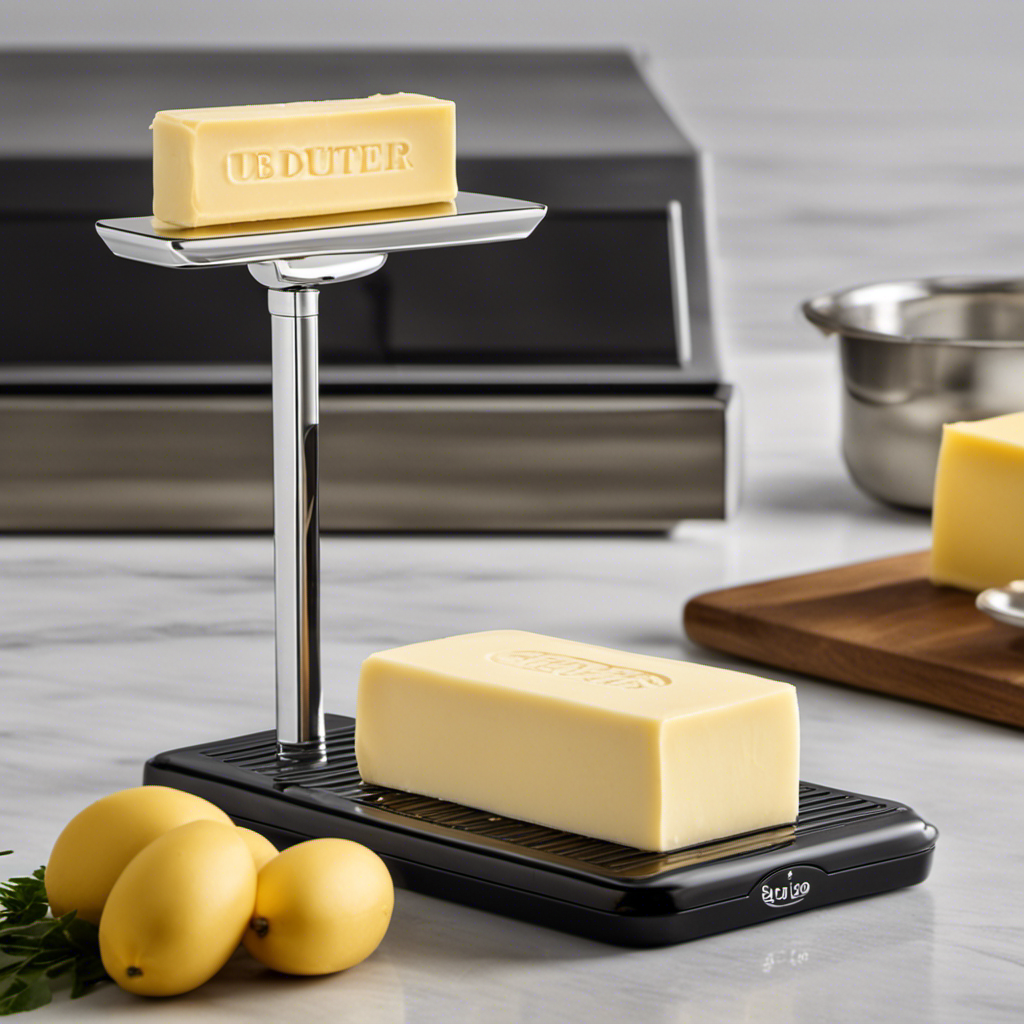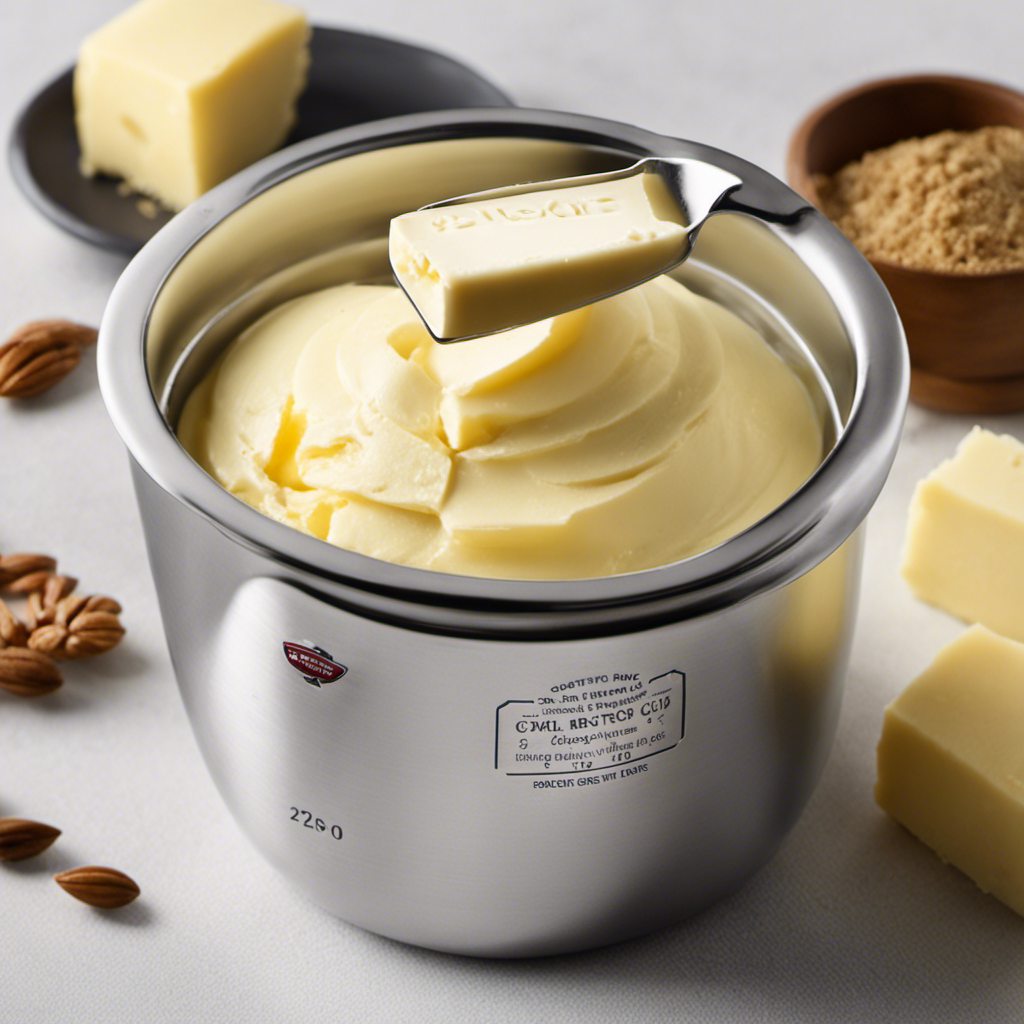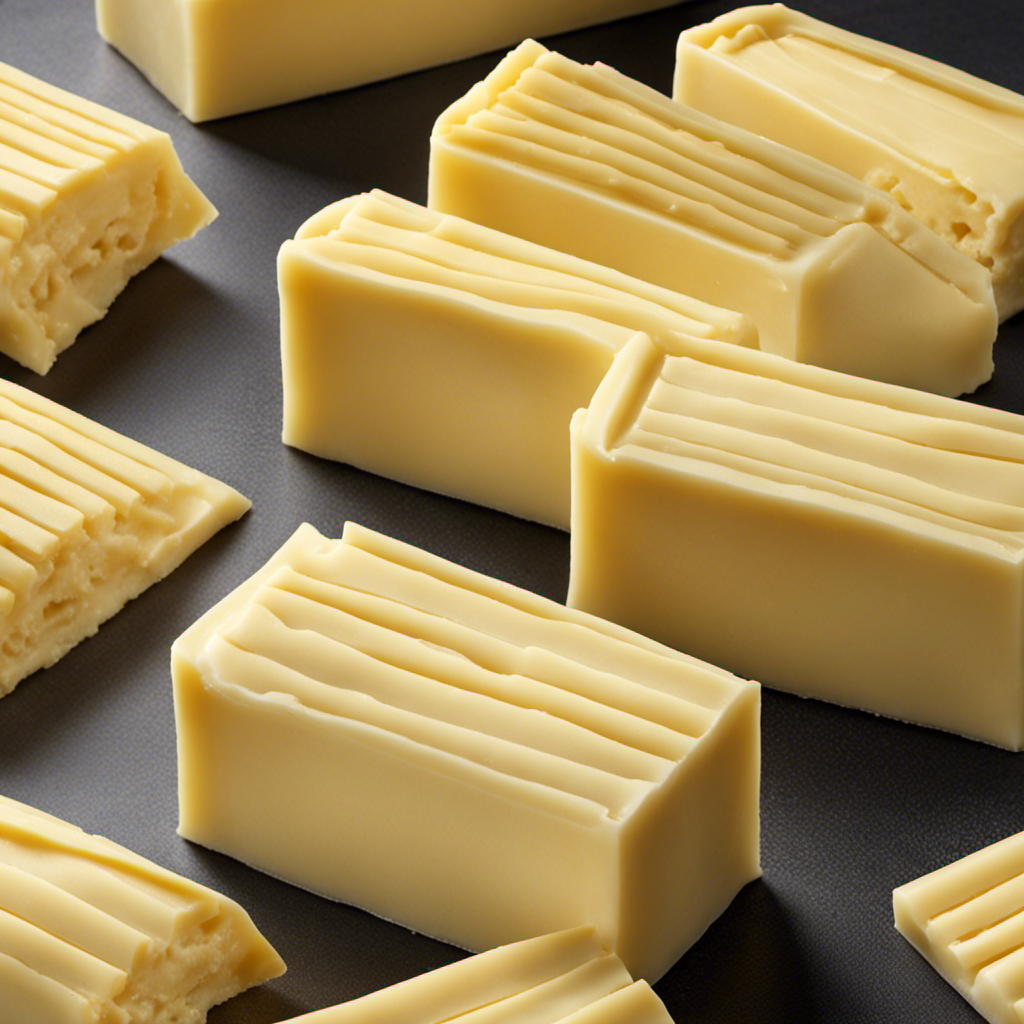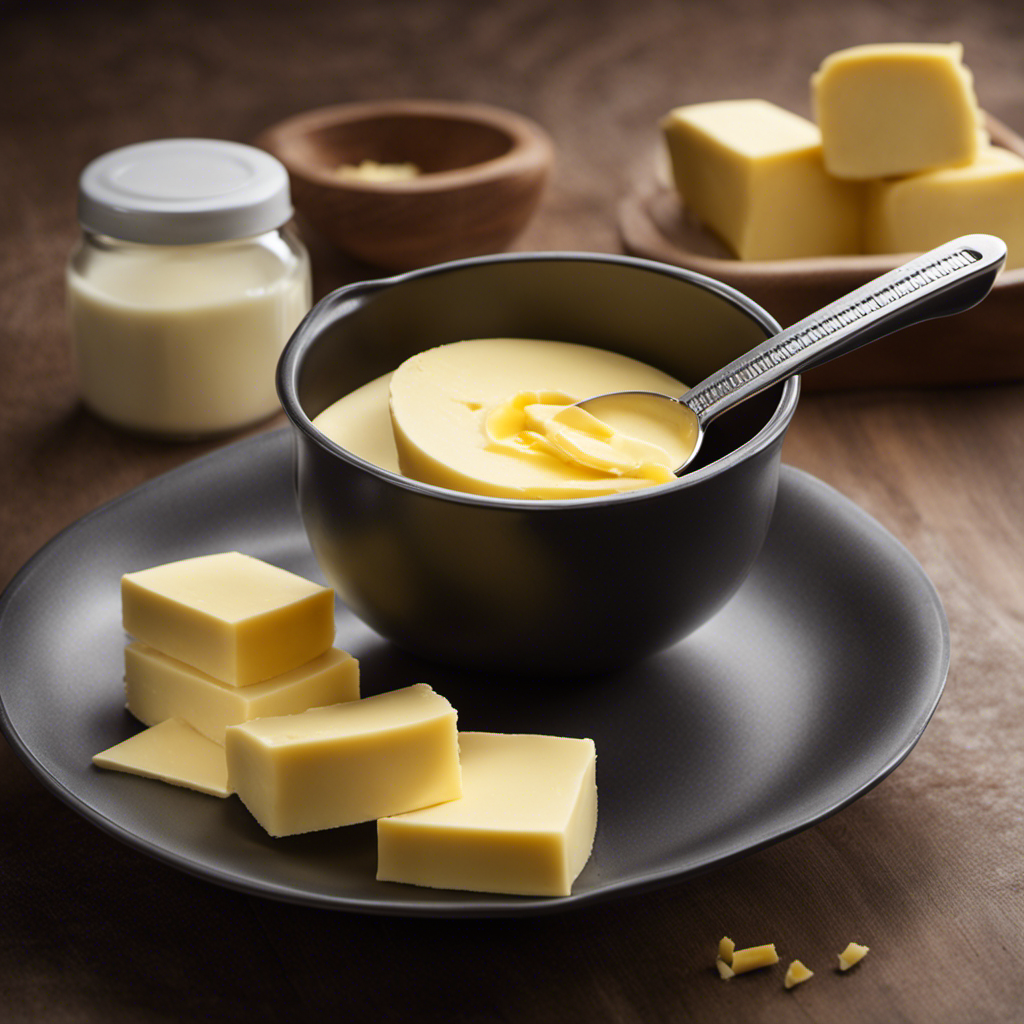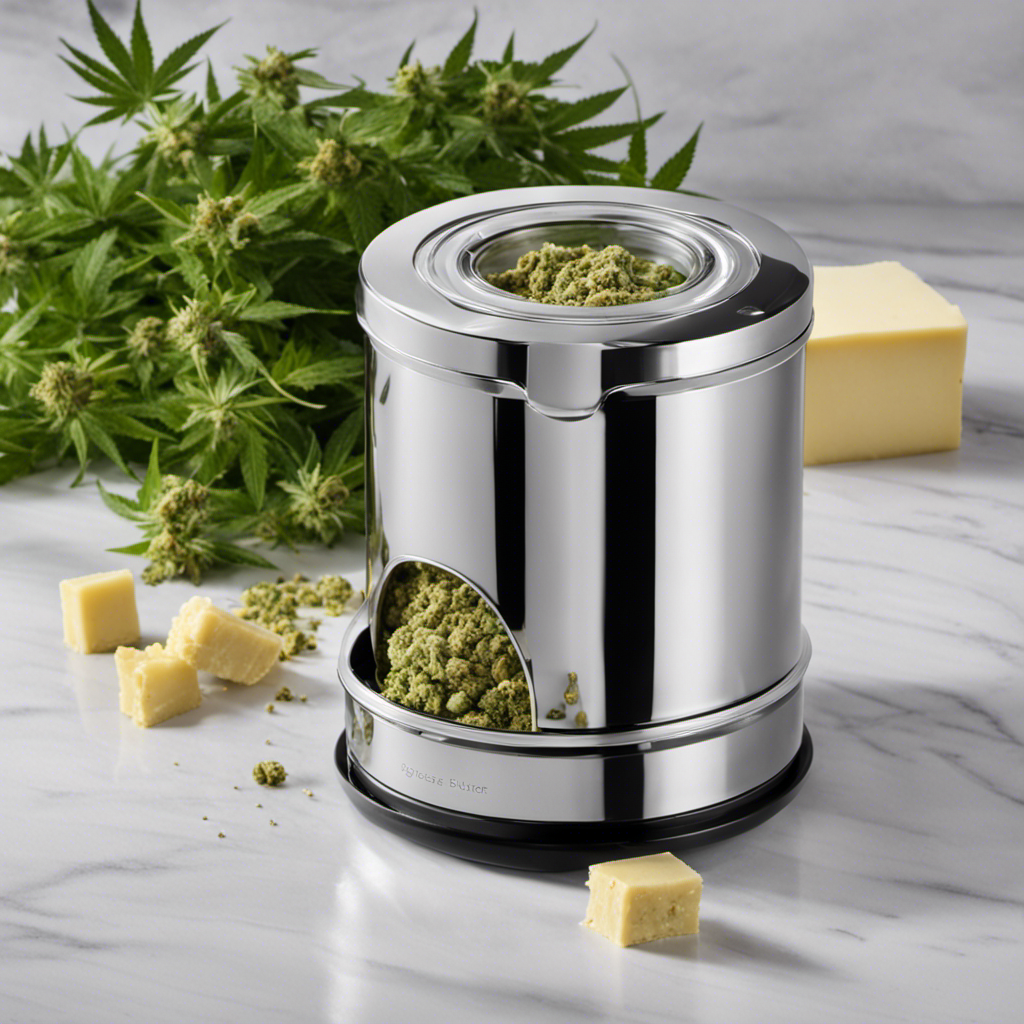I frequently find myself in the kitchen, experimenting with new recipes and mixing various ingredients together. One common query that pops up is the weight of one stick of butter in grams. This information is particularly vital for baking.
In this article, I will provide you with a precise answer, along with a handy conversion chart and some useful tips for incorporating butter into your culinary endeavors.
So let’s dive in and uncover the mysteries of butter measurements together.
Key Takeaways
- One stick of butter is equal to 113 grams or 1/2 cup.
- Butter is commonly sold in 1-pound blocks consisting of four sticks in the United States.
- In Europe, butter is often packaged in 250-gram blocks, equivalent to one European stick.
- Accurate measurement of butter is crucial for baking and cooking.
Understanding Butter Measurements
Understanding butter measurements can be confusing, especially with the various packaging sizes available. To make things easier, it’s helpful to know some butter measurement equivalents.
One stick of butter typically equals 113 grams or 1/2 cup. However, the packaging sizes can differ depending on the country or brand.
In the United States, butter is commonly sold in 1-pound blocks, which consists of four sticks. In Europe, butter is often packaged in 250-gram blocks, equivalent to one European stick.
Knowing these equivalents can be useful when following recipes from different regions.
Now that we understand the different butter packaging sizes, let’s delve into the standard size of a stick of butter.
The Standard Size of a Stick of Butter
When it comes to using butter in recipes, it’s important to be aware of the weight limit of a standard stick of butter. Typically, a stick of butter weighs 113 grams or 4 ounces, making it easy to measure for baking or cooking.
However, if you find yourself needing more or less butter, there are alternative packaging options available, such as larger tubs or individual portion packs, to ensure you have the perfect amount for your needs.
Butter Stick Weight Limit
To find out how many grams are in 1 stick of butter, you’ll need to check the weight limit specified on the packaging. The butter stick size can vary depending on the country or brand.
In the United States, a standard stick of butter is usually 4 ounces or 113 grams. The dimensions of a stick of butter are typically 4 inches long, 1 inch wide, and 0.75 inch thick.
These measurements are important to ensure accurate baking and cooking, as butter is a common ingredient in many recipes. It’s always a good idea to double-check the weight and dimensions of your butter sticks to make sure you’re using the correct amount for your desired dish.
Alternative Butter Packaging Options
There’s a range of different packaging options available for butter, such as tubs, blocks, or individual portion packets. These alternative butter packaging solutions offer various benefits and can cater to different needs.
Here are four reasons why using butter in different forms can be advantageous:
-
Convenience: Individual portion packets are great for on-the-go use or portion control, making it easy to grab and use just the right amount of butter.
-
Freshness: Tubs and blocks often have resealable lids or wrappers, ensuring the butter stays fresh for longer periods.
-
Versatility: Butter in block form allows for easy slicing or grating, making it convenient for cooking and baking purposes.
-
Portion control: Individual portion packets come in pre-measured amounts, helping to control calorie intake and reduce waste.
Converting Sticks of Butter to Grams
I always find it useful to know the weight of a stick of butter in grams, especially when following a recipe that calls for specific measurements.
In general, one stick of butter weighs about 113 grams, or 4 ounces.
It’s important to keep this in mind when converting recipes or when you need to adjust the amount of butter you’re using in a recipe.
Butter Stick Weight
The weight of 1 stick of butter is typically around 113 grams. Understanding butter packaging and butter measurement equivalents can be quite helpful in the kitchen. Here are four key points to consider when it comes to butter weights:
-
Butter packaging: Butter sticks are typically sold in packages with markings indicating the weight of each stick. This makes it easy to measure the exact amount needed for a recipe.
-
Measurement equivalents: If a recipe calls for a certain amount of butter in cups or tablespoons, it’s important to know the equivalent in stick form. One stick of butter is equal to 1/2 cup or 8 tablespoons.
-
Accuracy in baking: Baking often requires precise measurements, and understanding the weight of a stick of butter can ensure accurate results every time.
-
Convenience: Knowing the weight of a stick of butter makes it easy to quickly measure without the need for additional tools or conversions.
Understanding the weight of a stick of butter is essential for successful baking and cooking. Now, let’s delve into the topic of grams per stick.
Grams per Stick
Understanding the weight of a stick of butter is crucial for accurate measurement in recipes. As a home cook, I often find myself wondering how many grams are in one stick of butter. To help clarify this, I’ve put together a table comparing the different butter packaging and stick sizes commonly found in grocery stores.
| Butter Packaging | Stick Size |
|---|---|
| Box | 1/2 cup |
| Foil Wrap | 1/4 pound |
| Tub | 1 cup |
| Spreadable | 1/2 tablespoon |
How Many Grams in One Stick of Butter
Do you know how many grams are in one stick of butter?
Understanding butter measurements is crucial for any recipe. Here’s a breakdown of the conversions:
- A stick of butter typically weighs 113 grams or 4 ounces.
- This measurement is consistent across most butter brands in the United States.
- In European recipes, butter is commonly measured in grams, making conversions straightforward.
- Converting butter measurements can be tricky, but with a simple conversion chart, it becomes effortless.
Now that you know how many grams are in one stick of butter, let’s dive into the butter measurement conversion chart. It will help you easily convert between sticks, grams, ounces, and cups, ensuring accurate and delicious results in your baking endeavors.
Butter Measurement Conversion Chart
Once you have familiarized yourself with the butter measurement conversion chart, it will be easier for you to switch between different units of measurement in your recipes. The butter conversion chart provides a quick and convenient way to convert butter quantities from sticks to cups, grams, ounces, or tablespoons.
It is especially useful when you come across a recipe that uses a different unit of measurement than what you are accustomed to. For example, if a recipe calls for 1 cup of butter but you only have sticks of butter, you can refer to the chart to determine how many sticks are equivalent to 1 cup. This eliminates the need for guesswork and ensures that you use the correct amount of butter in your recipes.
Additionally, the butter conversion chart can also be helpful when using butter packaging alternatives, such as tubs or blocks, that do not come in the standard stick form. By referring to the chart, you can easily determine the equivalent amount of butter to use for your recipe, regardless of the packaging.
Overall, the butter conversion chart is a valuable tool that simplifies the process of measuring and using butter in your cooking and baking endeavors.
Tips for Using Butter in Baking and Cooking
Using butter in your baking and cooking can add richness and flavor to your dishes. Here are some tips and information about butter that will help you make the most of this versatile ingredient:
-
Butter storage tips:
- Keep butter in the refrigerator to maintain its freshness and prevent spoilage.
- Store butter in an airtight container to prevent it from absorbing odors from other foods.
- If you use butter frequently, consider keeping a small amount at room temperature for easy spreading.
-
Different types of butter for baking:
- Unsalted butter is a common choice for baking as it allows you to control the amount of salt in your recipe.
- European-style butter has a higher fat content, resulting in a richer and creamier texture in baked goods.
Frequently Asked Questions
How Many Calories Are in One Stick of Butter?
In one stick of butter, there are approximately 810 calories. It’s important to note that butter is high in saturated fat and should be consumed in moderation as part of a balanced diet.
Can I Substitute Margarine for Butter in a Recipe?
When substituting margarine for butter in a recipe, it’s important to understand the nutritional differences. Margarine is often lower in saturated fat and cholesterol. However, butter adds a rich flavor that margarine may lack.
How Long Does Butter Last in the Refrigerator?
Properly storing butter in the refrigerator is essential to maintain its freshness. It is recommended to use an airtight container to prevent absorption of odors. Additionally, using unsalted butter allows for better control of the flavor in recipes.
Is It Possible to Freeze Butter?
Yes, it is possible to freeze butter. Freezing helps to extend its shelf life. When you freeze butter, it becomes solid and retains its flavor and texture. Be sure to wrap it tightly to prevent freezer burn.
How Can I Soften Butter Quickly for Baking?
To quickly soften butter for baking, I use a secret technique that makes it melt in seconds. It’s so easy, you won’t believe it! Just follow my quick butter softening method and you’ll be ready to bake in no time.
Conclusion
In conclusion, understanding the measurements of butter is essential for any cooking or baking enthusiast. Converting sticks of butter to grams may seem like a daunting task, but with the help of a conversion chart, it becomes a breeze.
Just remember, one stick of butter is equivalent to 113 grams. To add depth to this concept, think of a stick of butter as a tiny beacon of flavor, melting and infusing its richness into every dish it touches, much like a single drop of rain can bring life to a parched desert.
So embrace the magic of butter and let it transform your culinary creations!
